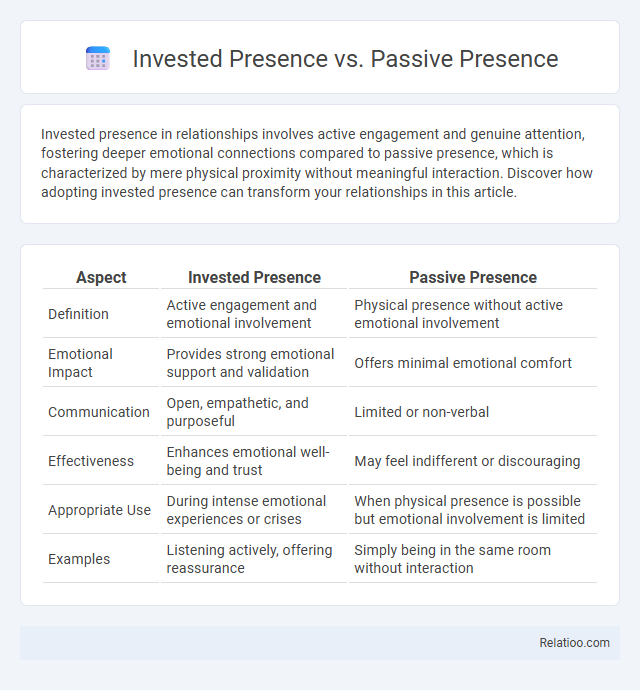Invested presence in relationships involves active engagement and genuine attention, fostering deeper emotional connections compared to passive presence, which is characterized by mere physical proximity without meaningful interaction. Discover how adopting invested presence can transform your relationships in this article.
Table of Comparison
| Aspect | Invested Presence | Passive Presence |
|---|---|---|
| Definition | Active engagement and emotional involvement | Physical presence without active emotional involvement |
| Emotional Impact | Provides strong emotional support and validation | Offers minimal emotional comfort |
| Communication | Open, empathetic, and purposeful | Limited or non-verbal |
| Effectiveness | Enhances emotional well-being and trust | May feel indifferent or discouraging |
| Appropriate Use | During intense emotional experiences or crises | When physical presence is possible but emotional involvement is limited |
| Examples | Listening actively, offering reassurance | Simply being in the same room without interaction |
Understanding Invested Presence
Invested Presence requires your active engagement, deep emotional connection, and conscious awareness in interactions, distinguishing it from Passive Presence, which involves mere physical availability without full engagement. Understanding Invested Presence enhances your ability to create meaningful relationships by fostering genuine attentiveness and intentional participation. This conscious involvement boosts communication effectiveness and strengthens emotional bonds in personal and professional settings.
Defining Passive Presence
Passive Presence refers to a state of engagement where your attention is minimally directed toward the environment or activity, often involving observation without active participation or emotional investment. Unlike Invested Presence, which requires deep focus and commitment, Passive Presence allows you to be physically present but mentally detached, leading to limited impact on outcomes. Understanding this distinction helps optimize your mindfulness and effectiveness in various personal or professional settings.
Key Differences Between Invested and Passive Presence
Invested presence involves active engagement and emotional commitment, where individuals participate meaningfully and influence outcomes, while passive presence refers to mere physical attendance without active involvement or emotional investment. The key differences lie in the level of attention, interaction, and impact on the environment or group; invested presence enhances collaboration and productivity, whereas passive presence often leads to disengagement and minimal contribution. Understanding these distinctions helps organizations foster a culture that encourages active participation and deeper connection.
Benefits of Cultivating Invested Presence
Cultivating invested presence enhances your engagement by fostering deeper connections and promoting mindfulness in interactions, leading to increased productivity and emotional intelligence. Unlike passive presence, which often leads to distractions and reduced focus, invested presence encourages active listening and thoughtful participation, benefiting both personal and professional relationships. Developing this skill boosts your ability to respond empathetically and adaptively, improving collaboration and overall well-being.
Risks of Relying on Passive Presence
Relying solely on Passive Presence exposes Your business to significant risks, including diminished customer engagement, reduced brand loyalty, and missed growth opportunities due to lack of active interaction. Invested Presence enhances market credibility by fostering genuine connections and continuous value delivery, while Passive Presence often results in stagnation amid competitive markets. Without proactive involvement, your brand may struggle to adapt to evolving consumer needs and digital trends, risking long-term relevance and profitability.
Recognizing Signs of Invested Presence
Recognizing signs of invested presence involves observing active engagement, emotional availability, and meaningful responsiveness in interactions, contrasted with passive presence where attention is minimal and disengaged. Invested presence reflects genuine connection, characterized by focused attention, empathetic listening, and intentional participation. Indicators include sustained eye contact, appropriate verbal and nonverbal feedback, and proactive involvement in conversations or activities.
Common Habits of Passive Presence
Common habits of passive presence include minimal engagement, surface-level attention, and delayed responsiveness, often leading to missed opportunities for deeper connection. Individuals practicing passive presence tend to disengage during conversations, rely heavily on multitasking, and exhibit limited emotional investment. These behaviors contrast sharply with the active involvement and mindful awareness characteristic of invested presence.
Strategies to Shift from Passive to Invested Presence
Shifting from passive to invested presence requires deliberate strategies such as active engagement in communication, consistent participation in collaborative activities, and cultivating emotional intelligence to connect deeply with others. Implementing regular feedback loops and setting clear personal involvement goals enhance mindfulness and responsiveness in interactions, fostering an invested presence. Using digital tools to track contributions and reflect on engagement patterns supports sustained transition towards deeper, more meaningful presence in professional and social contexts.
Real-Life Examples: Invested vs Passive Presence
Invested presence involves actively engaging with your audience through personalized interactions and meaningful content, as seen in brands like Nike that foster strong community connections via social media and events. Passive presence, by contrast, relies on maintaining visibility without direct engagement, exemplified by companies that only post scheduled updates without responding to customer feedback, leading to weaker brand loyalty. Real-life examples highlight that invested presence drives higher customer trust and retention, while passive presence often results in missed opportunities for deeper relationships.
Impact of Presence on Personal and Professional Success
Invested Presence enhances personal and professional success by fostering deep engagement, active listening, and intentional interaction, leading to stronger relationships and improved productivity. Passive Presence, characterized by mere physical attendance without genuine focus, often results in missed opportunities for meaningful connections and growth. This deliberate investment in presence cultivates trust, sharpens decision-making, and elevates leadership effectiveness across diverse contexts.

Infographic: Invested Presence vs Passive Presence
 relatioo.com
relatioo.com